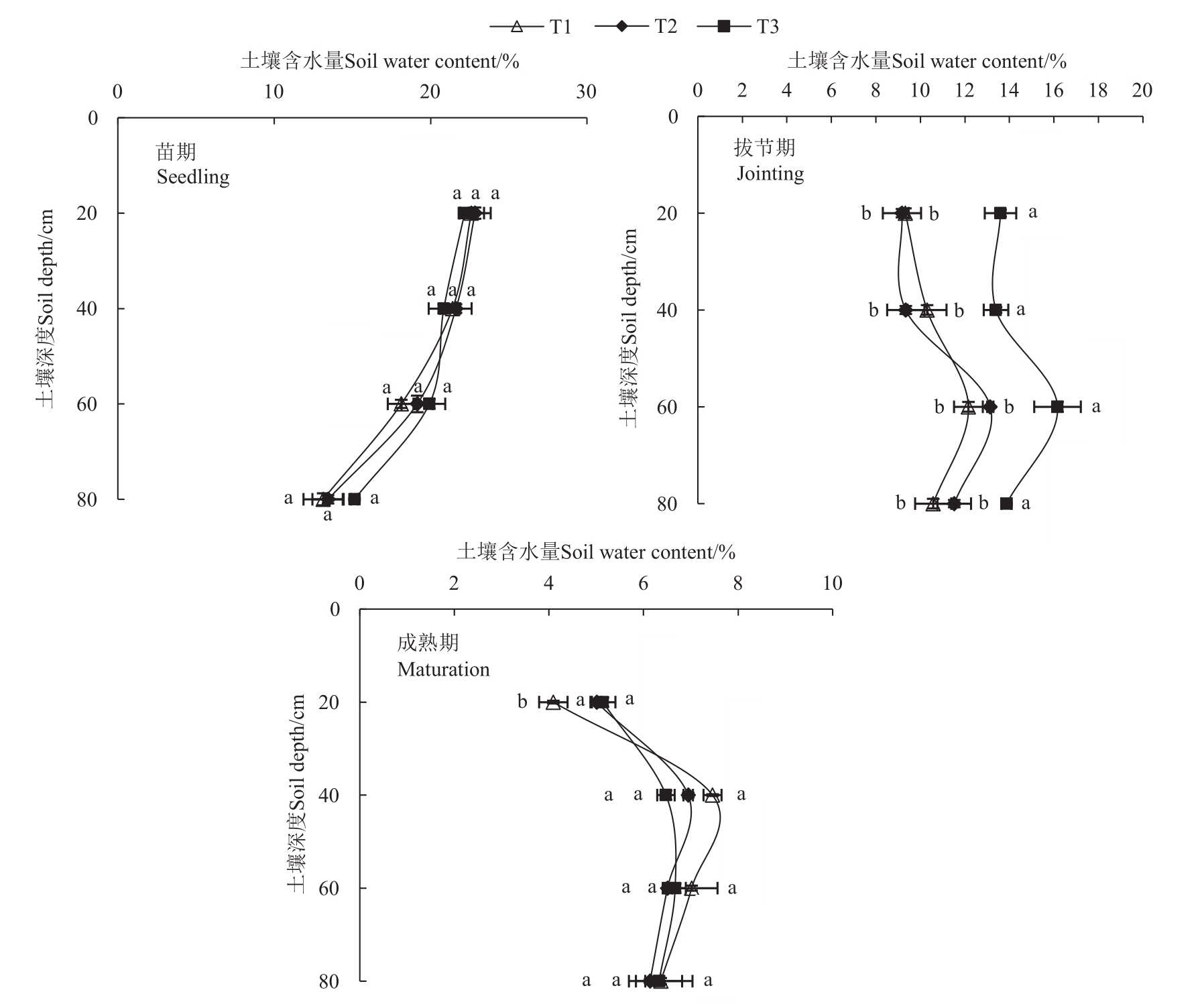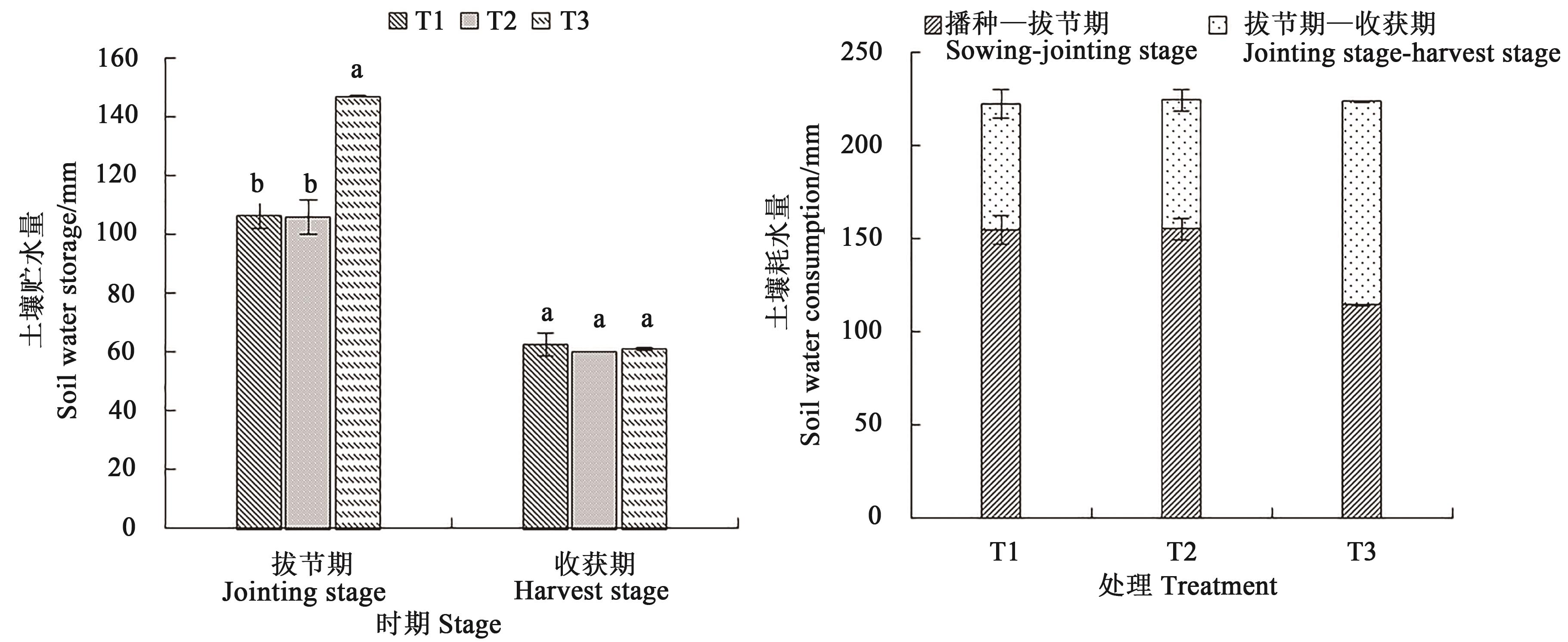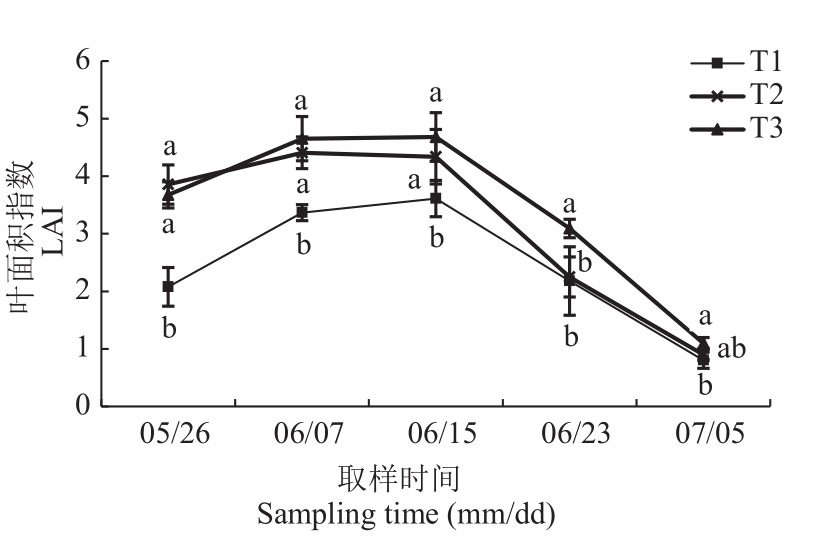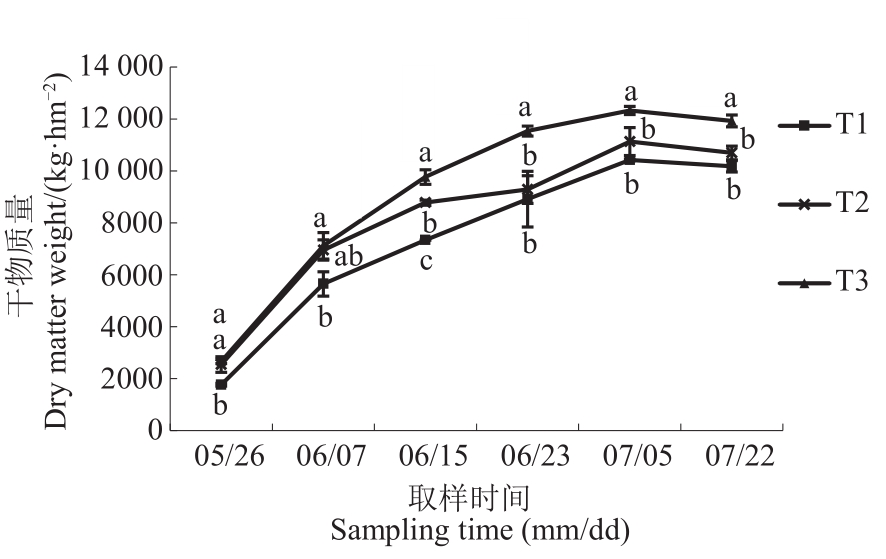




















中国农业科技导报 ›› 2024, Vol. 26 ›› Issue (1): 173-181.DOI: 10.13304/j.nykjdb.2022.0718
• 生物制造 资源生态 • 上一篇
房彦飞( ), 罗晓颖, 唐江华, 孙婷婷, 王鲁振, 唐甜, 徐文修(
), 罗晓颖, 唐江华, 孙婷婷, 王鲁振, 唐甜, 徐文修( )
)
收稿日期:2022-08-29
接受日期:2022-10-31
出版日期:2024-01-15
发布日期:2024-01-08
通讯作者:
徐文修
作者简介:房彦飞 E-mail:13009634490@163.com;
基金资助:
Yanfei FANG( ), Xiaoying LUO, Jianghua TANG, Tingting SUN, Luzhen WANG, Tian TANG, Wenxiu XU(
), Xiaoying LUO, Jianghua TANG, Tingting SUN, Luzhen WANG, Tian TANG, Wenxiu XU( )
)
Received:2022-08-29
Accepted:2022-10-31
Online:2024-01-15
Published:2024-01-08
Contact:
Wenxiu XU
摘要:
为提高新疆旱地春小麦产量及水分利用效率,筛选出适宜的播种方式,采用单因素随机区组试验,设置传统平作(T1)、起垄沟播(T2)、起垄覆膜沟播(T3)3个播种方式,研究不同播种方式下旱地的土壤含水量及春小麦的叶面积指数(leaf area index,LAI)、干物质量、产量,并进一步比较土壤贮水量、耗水量及水分利用效率等。结果表明,在抽穗期之前,T2和T3处理均可显著增加旱地春小麦的LAI和干物质量;在抽穗期之后,T3处理较T2和T1处理更有利于提高旱地春小麦的LAI和干物质量。同时,T3处理可显著提高拔节期土壤0—80 cm土层的含水量和贮水量,分别较T2、T1处理显著提高32.09%、34.64%和38.20%、38.85%;T3处理降低了播种—拔节期土壤耗水量,增加了拔节期—收获期的土壤耗水量,有利于植株中、后期的生长发育。T3处理可提高旱地春小麦的有效穗数、单穗粒数、籽粒产量、水分利用效率和降水利用效率,其中产量最高为2 474.43 kg·hm-2,较T1、T2处理分别显著增加50.13%和50.47%;水分利用效率和降水利用效率分别显著提高48.99%、51.02%和49.41%、50.15%。综上所述,起垄覆膜沟播有利于小麦增产和水分高效利用,为新疆旱地春小麦蓄水保墒和高产高效提供了理论依据及技术参考。
中图分类号:
房彦飞, 罗晓颖, 唐江华, 孙婷婷, 王鲁振, 唐甜, 徐文修. 播种方式对旱地春小麦产量、干物质及水分利用效率的影响[J]. 中国农业科技导报, 2024, 26(1): 173-181.
Yanfei FANG, Xiaoying LUO, Jianghua TANG, Tingting SUN, Luzhen WANG, Tian TANG, Wenxiu XU. Effects of Sowing Methods on Yield, Dry Matter and Water Use Efficiency of Spring Wheat in Dryland[J]. Journal of Agricultural Science and Technology, 2024, 26(1): 173-181.
月份 Month | 4月11—30日 April 11th to 30th | 5月 May | 6月 June | 7月1—27日 July 1st to 27th | 全生育期 Growth period |
|---|---|---|---|---|---|
降水量 Precipitation | 28.0 | 50.2 | 17.0 | 6.6 | 101.8 |
表1 2021年旱地春小麦生育期间降水量 (mm)
Table 1 Precipitation during the dryland spring wheat fertility period in 2021
月份 Month | 4月11—30日 April 11th to 30th | 5月 May | 6月 June | 7月1—27日 July 1st to 27th | 全生育期 Growth period |
|---|---|---|---|---|---|
降水量 Precipitation | 28.0 | 50.2 | 17.0 | 6.6 | 101.8 |

图1 不同播种方式下旱地春小麦各生育时期0—80 cm土层的土壤含水量注:相同土壤深度不同小写字母表示不同处理间在P<0.05水平差异显著。
Fig. 1 Soil water contents in 0-80 cm soil layer during dryland spring wheat growth period under different sowing methodsNote: Different lowercase letters of same soil layer indicate significant differences between different treatments at P<0.05 level.

图2 不同播种方式下旱地小麦的土壤贮水量和耗水量注:不同小写字母表示不同处理间在P<0.05水平差异显著。
Fig. 2 Soil water storage and water consumption of dryland wheat under different sowing methodsNote: Different lowercase letters indicate significant differences between different treatments at P<0.05 level.

图3 不同播种方式下旱地小麦的叶面积指数注:同一时期不同小写字母表示不同处理间在P<0.05水平差异显著。
Fig. 3 Leaf area index of dryland wheat under different sowing methodsNote: Different lowercase letters of same growth period indicate significant differences between different treatments at P<0.05 level.

图4 不同播种方式下旱地小麦的干物质积累量注:同一时期不同小写字母表示不同处理间在P<0.05水平差异显著。
Fig. 4 Dry matter accumulation of dryland wheat under different sowing methodsNote: Different lowercase letters of same growth period indicate significant differences between different treatments at P<0.05 level.
处理 Treatment | 有效穗数 Number of productive ears/(104·hm-2) | 单穗粒数 Kernels per spike | 千粒重 1 000-grainweigh/g | 产量 Yield /(kg·hm-2) | 水分利用效率 Water use efficiency/ (kg·mm-1·hm-2) | 降水利用效率 Rainfall use efficiency/ (kg·mm-1·hm-2) |
|---|---|---|---|---|---|---|
| T1 | 241.84±15.95 bB | 28.44±1.70 bB | 31.89±1.20 aA | 1 648.19±66.15 bB | 7.43±0.13 bB | 16.19±0.65 bB |
| T2 | 256.43±8.59 bB | 27.02±1.43 bB | 30.88±1.98 abA | 1 644.45±103.11 bB | 7.33±0.10 bB | 16.15±1.02 bB |
| T3 | 313.10±12.93 aA | 35.09±0.74 aA | 28.53±0.23 bA | 2 474.43±95.44 aA | 11.07±0.02 aA | 24.31±0.93 aA |
表2 不同播种方式下旱地小麦的产量及水分利用
Table 2 Yield and water use of dryland wheat under different sowing methods
处理 Treatment | 有效穗数 Number of productive ears/(104·hm-2) | 单穗粒数 Kernels per spike | 千粒重 1 000-grainweigh/g | 产量 Yield /(kg·hm-2) | 水分利用效率 Water use efficiency/ (kg·mm-1·hm-2) | 降水利用效率 Rainfall use efficiency/ (kg·mm-1·hm-2) |
|---|---|---|---|---|---|---|
| T1 | 241.84±15.95 bB | 28.44±1.70 bB | 31.89±1.20 aA | 1 648.19±66.15 bB | 7.43±0.13 bB | 16.19±0.65 bB |
| T2 | 256.43±8.59 bB | 27.02±1.43 bB | 30.88±1.98 abA | 1 644.45±103.11 bB | 7.33±0.10 bB | 16.15±1.02 bB |
| T3 | 313.10±12.93 aA | 35.09±0.74 aA | 28.53±0.23 bA | 2 474.43±95.44 aA | 11.07±0.02 aA | 24.31±0.93 aA |
| 1 | 张扬,楚新正,杨少敏,等.近56 a新疆北部地区气候变化特征[J].干旱区研究,2019,36(1):212-219 |
| ZHANG Y, CHU X Z, YANG S M, et al.. Climate change in north Xinjiang in recent 56 years [J]. Arid Zone Res., 2019, 36(1):212-219. | |
| 2 | 陈虹.新疆统计年鉴[M].北京:中国统计出版社,2017. |
| 3 | 李永平,贾志宽,刘世新,等.起垄覆膜集水技术对苜蓿土壤水分状况的影响[J].西北农业学报,2008(6):237-241. |
| LI Y P, JIA Z K, LIU S X, et al.. The characteristics of soil amelioration by water harvesting by ridge building of medicago sativa and its effect on regional water budget [J]. Acta Agric. Bor-Occid. Sin., 2008(6):237-241. | |
| 4 | 靳乐乐,乔匀周,董宝娣,等.起垄覆膜栽培技术的增产增效作用与发展[J].中国生态农业学报,2019,27(9):1364-1374. |
| JIN L L, QIAO Y Z, DONG B D, et al.. Crop yield increasing and efficiency improving effects and development of technology of ridge-furrow cultivation with plastic film mulching [J]. Chin. J. Eco-Agric., 2019, 27(9):1364-1374. | |
| 5 | 樊丽琴,李磊,吴霞,等.种植方式对宁夏银北灌区盐碱地土壤水热盐及玉米生长的影响[J].土壤通报,2020,51(6):1403-1408. |
| FAN L Q, LI L, WU X, et al.. Effects of planting patterns on soil moisture, temperature, salt content and maize growth in a saline-alkali land of Yinbei irrigation area [J]. J. Soil Sci., 2020, 51(6):1403-1408. | |
| 6 | 蒙强,刘静霞,张恒嘉.我国黄土高原旱作农业沟垄覆膜栽培技术研究进展[J].贵州农业科学,2015,43(8):72-82. |
| MENG Q, LIU J X, ZHANG H J. Advances in cultivation technique with film mulching in ridge and furrow in dryland farming of the loess plateau [J]. Guizhou Agric. Sci., 2015, 43(8):72-82. | |
| 7 | RICHARDS R A, REBETZKE G J, CONDON A G, et al.. Breeding opportunities for increasing the efficiency of water use and crop yield in temperate cereals [J]. Crop Sci., 2002, 42(1):111-121. |
| 8 | 宋秉海.旱地地膜玉米“贫水富集”种植模式研究[J].中国生态农业学报,2006,14(3):93-95. |
| SONG B H. Study on planting models of rainwater harvesting technique of mulched maize in arid areas [J]. Chin. J. Eco-Agric., 2006, 14(3):93-95. | |
| 9 | 李儒,崔荣美,贾志宽,等.不同沟垄覆盖方式对冬小麦土壤水分及水分利用效率的影响[J].中国农业科学,2011,44(16):3312-3322. |
| LI R, CUI R M, JIA Z H, et al.. Effects of different furrow-ridge mulching ways on soil moisture and water use efficiency of winter wheat [J]. Sci. Agric. Sin., 2011, 44(16):3312-3322. | |
| 10 | QIN S H, ZHANG J L, DAI H L, et al.. Effect of ridge-furrow and plastic-mulching planting patterns on yield formation and water movement of potato in a semi-arid area [J]. Agric. Water Manage., 2014, 131:87-94. |
| 11 | 冯浩,王杰,王乃江,等.起垄覆膜条件下夏玉米农田耗水过程分析[J].农业机械学报,2018,49(9):205-213. |
| FENG H, WANG J, WANG N J, et al.. Analysis of water consumption in summer maize field under planting pattern of ridge-furrow with plastic film mulching [J]. Trans. Chin. Soc. Agric. Mach., 2018, 49(9):205-213. | |
| 12 | 王同花,李援农.起垄覆膜沟播对冬小麦土壤水分利用效率及土壤温度的影响[J].中国农村水利水电,2011,(1):46-49. |
| WANG T H, LI Y N. Effect of furrow planting winter wheat with plastic film mulching on water use efficiency and soil temperature [J]. China Rural Water Hydropower, 2011, (1):46-49. | |
| 13 | 陈辉林,田霄鸿,王晓峰,等.不同栽培模式对渭北旱塬区冬小麦生长期间土壤水分、温度及产量的影响[J].生态学报,2010,30(9):2424-2433. |
| CHEN H L, TIAN X H, WANG X F, et al.. Effects of different cultivation models on soil water、soil temperature and yield during the winter wheat growth in the Weibei dry highland [J]. Acta Ecol. Sin., 2010, 30(9):2424-2433. | |
| 14 | 李廷亮,谢英荷,任苗苗,等.施肥和覆膜垄沟种植对旱地小麦产量及水氮利用的影响[J].生态学报报,2011,31(1):212-220. |
| LI T L, XIE Y H, REN M M, et al.. Effects of fertilization and plastic film mulched ridge-furrow cultivation on yield and water and nitrogen utilization of winter wheat on dryland [J]. Acta Ecol. Sin., 2011, 31(1):212-220. | |
| 15 | 王晓凌,陈明灿,易现峰,等.垄沟覆膜集雨系统垄宽和密度效应对玉米产量的影响[J].农业工程学报,2009,25(8):40-47. |
| WANG X L, CHEN M C, YI X F, et al.. Effects of ridge width and planting density on corn yields in rainwater-harvesting system with plastic film mulching on ridge [J]. Trans. Chin. Soc. Agric. Eng., 2009, 25(8):40-47. | |
| 16 | 李吾强,温晓霞,高茂盛,等.半湿润区旱作起垄覆膜沟播小麦的水分及生理效应研究[J].西北农业学报,2008,(5):146-151. |
| LI W Q, WEN X X, GAO M S, et al.. Studies on water and physiological effect of winter wheat with plastic film mulching in semiarid farmland [J]. Acta Agric. Bor-Occid. Sin., 2008, (5):146-151. | |
| 17 | 吴兵,高玉红,李映,等.不同覆膜方式对西北旱地麦田土壤水热特征和产量形成的影响[J].西北农业学报,2018,27(5):741-749. |
| WU B, GAO Y H, LI Y, et al.. Influences of different plastic film mulches on soil temperature and grain yield of spring wheat in northwest arid land of China [J]. Acta Agric. Bor-Occid. Sin., 2018, 27(5):741-749. | |
| 18 | 张德奇,廖允成,贾志宽.旱区地膜覆盖技术的研究进展及发展前景[J].干旱地区农业研究,2005(1):208-213. |
| ZHANG D Q, LIAO Y C, JIA Z K. Research advances and prospects of film mulching in arid and semiarid areas [J]. Agric. Res. Arid Areas, 2005(1):208-213. | |
| 19 | 王红丽,张绪成,宋尚有,等.西北黄土高原旱地全膜双垄沟播种植对玉米季节性耗水和产量的调节机制[J].中国农业科学,2013,46(5):917-926. |
| WANG L H, ZHANG X C, SONG S Y, et al.. Regulation of whole field surface plastic mulching and double ridge-furrow planting on seasonal soil water loss and maize yield in rain-fed area of northwest loess plateau [J]. Sci. Agric. Sin., 2013, 46(5):917-926. | |
| 20 | 王俊,李凤民,宋秋华,等.地膜覆盖对土壤水温和春小麦产量形成的影响[J].应用生态学报,2003(2):205-210. |
| WANG J, LI F M, SONG Q H, et al.. Effects of plastic film mulching on soil temperature and moisture and on yield formation of spring wheat [J]. Chin. J. Appl. Ecol., 2003(2):205-210. | |
| 21 | 王同花.垄上覆膜沟播冬小麦生态效应与产量及节水效应研究[D].杨凌:西北农林科技大学,2011. |
| WANG T H. Research on physiological and yield and water effect of winter wheat with plastic film mulching in semiarid farmland [D]. Yangling: Northwest A&F University, 2011. | |
| 22 | 黄素芳,刘振敏,白艳梅,等.环渤海雨养旱作区冬小麦起垄覆膜侧播种植模式研究[J].作物研究,2017,31(5):477-481, 523. |
| HUANG S F, LIU Z M, BAI Y M, et al.. Study on the furrow planting modes with ridge film mulching of the winter wheat in the rain-fed areas around Bohai [J]. Crop Res., 2017, 31(5):477-481, 523. | |
| 23 | 张婷,吴普特,赵西宁,等.垄沟种植模式对玉米生长及产量的影响[J].干旱地区农业研究,2013,21(1):27-30, 40. |
| ZHANG T, WU P T, ZHAO X N, et al.. Effects of ridge and furrow planting system on growth and yield of maize [J]. Agric. Res. Arid Areas, 2013, 21(1):27-30, 40. | |
| 24 | 冯攀,韩玉娥,张毅,等.西藏地区不同旱作方式对马铃薯水分利用率和产量的影响[J].安徽农学通报,2018,24(8):29-32, 89. |
| FENG P, HAN Y E, ZHANG Y, et al.. The impact of different planting mode on the water efficiency and production of potatoes in Tibet area [J]. Anhui Agric. Sci. Bull., 2018, 24(8):29-32, 89. | |
| 25 | 王彩绒,田霄鸿,李生秀.沟垄覆膜集雨栽培对冬小麦水分利用效率及产量的影响[J].中国农业科学,2004,37(2):208-214. |
| WANG C R, TIAN X H, LI S X. Effects of plastic sheet-mulching on ridge for rainwater-harvesting cultivation on WUE and yield of winter wheat [J]. Sci. Agric. Sin., 2004, 37(2):208-214. | |
| 26 | LI X Y, ZHAO W W, SONG Y X, et al.. Rainfall harvesting on slopes using contour furrows with plastic-covered transverse ridges for growing Caragana korshinskii in the semiarid region of China [J]. Agric. Water Manage., 2008, 95:539-544. |
| 27 | 任小龙,贾志宽,陈小莉,等.半干旱区沟垄集雨对玉米光合特性及产量的影响[J].作物学报,2008,34(5):838-845. |
| REN X L, JIA Z K, CHEN X L, et al.. Effects of ridge and furrow planting for rainfall harvesting on photosynthetic characteristics and yield in corn in semi-arid regions [J]. Acta Agron. Sin., 2008, 34(5):838-845. | |
| 28 | 刘宏胜,吴兵,高玉红,等.旱区集雨种植方式对春小麦产量和水分利用效率的影响[J].土壤通报,2018,49(4):862-868. |
| LIU H S, WU B, GAO Y H, et al.. Effects of rainfall harvesting planting on grain yield and water use efficiency of spring wheat in semi-arid areas [J]. J. Soil Sci., 2018, 49(4):862-868. | |
| 29 | 纪文宁,程宏波,李亚伟,等.覆盖方式对旱地马铃薯阶段耗水量特征和产量的影响[J].水土保持学报,2022,36(3):228-235. |
| JI W N, CHEN H B, LI Y W, et al.. Effects of mulching methods on water consumption and yield of potato in dryland farming [J]. J. Soil Water Conserv., 2022, 36(3):228-235. | |
| 30 | MADSEN M H, CHRISTENSEN D H. Changes in viscosity properties of potato starch during growth [J]. Starch Starke, 2010, 48(7/8):245-249. |
| 31 | 张谦,冯国艺,雷晓鹏,等.滨海盐碱地预覆膜起垄的生态效应及对棉花苗期的影响[J].干旱地区农业研究,2018,36(4):74-79. |
| ZHANG Q, FENG G Y, LEI X P, et al.. Ecological effects of early plastic mulching and ridging and its effect on seedling stage of cotton in coastal saline soil [J]. Agric. Res. Arid Areas, 2018, 36(4):74-79. | |
| 32 | 魏虹,李凤民.短期地膜覆盖对半干旱区春小麦生长发育和产量的影响[J].农业现代化研究,2001(4):253-256. |
| WEI H, LI F M. Effects of short term plastic film mulching on the growth and yield of spring wheat in the semi arid region [J]. Agric. Mod. Res., 2001(4):253-256. | |
| 33 | 李凤民,鄢珣,王俊,等.地膜覆盖导致春小麦产量下降的机理[J].中国农业科学,2001(3):330-333. |
| LI F M, YAN X, WANG J, et al.. The mechanism of yield decrease of spring wheat resulted from plastic film mulching [J]. Sci. Agric. Sin., 2001(3):330-333. |
| [1] | 王辉, 付虹雨, 岳云开, 崔国贤, 佘玮. 基于气候变量的苎麻产量SSA-BP预测模型[J]. 中国农业科技导报, 2024, 26(1): 110-118. |
| [2] | 段媛媛, 刘晓洪, 唐涛, 王帆帆, 游景茂, 郭晓亮, 郭杰. 种植密度对湖北贝母生长及品质的影响[J]. 中国农业科技导报, 2023, 25(9): 197-206. |
| [3] | 周影, 李京咏, 戴林秀, 敖弟彩, 李梓逸, 杨帆, 顾军伟, 徐强, 窦志, 高辉. 稻虾共作模式下喷施褪黑素对水稻产量形成和抗倒伏特性的影响[J]. 中国农业科技导报, 2023, 25(9): 34-42. |
| [4] | 王为, 赵强, 穆妮热·阿卜杜艾尼, 阿里木·阿木力null, 李欣欣, 田阳青. 烯效唑复配不同外源物质对棉花化学封顶及产量品质的影响[J]. 中国农业科技导报, 2023, 25(9): 57-68. |
| [5] | 张晨阳, 徐明岗, 王斐, 李然, 孙楠. 施用有机肥对我国大豆产量及土壤养分的影响[J]. 中国农业科技导报, 2023, 25(8): 148-156. |
| [6] | 郑志刚, 向丽, 刘功义, 徐彩, 覃斌, 王慰亲, 郑华斌, 唐启源. 施氮量和密度对有序机抛早稻生长发育和产量的影响[J]. 中国农业科技导报, 2023, 25(7): 132-143. |
| [7] | 孟亚轩, 马玮, 姚旭航, 孙颖琦, 钟鑫, 黄山, 瓮巧云, 刘颖慧, 袁进成. 玉米产量对氮肥的响应因素研究[J]. 中国农业科技导报, 2023, 25(7): 153-160. |
| [8] | 周文, 郭笑恒, 徐锐, 王晓丽, 牛慧伟, 韩丹, 邵惠芳. 烤烟间作半夏对烤烟生长及产量和品质的影响[J]. 中国农业科技导报, 2023, 25(7): 161-169. |
| [9] | 陈登龙, 张雨翔, 宋佳佳, 陈鹏宇, 温祥珍, 李亚灵. 火山石沉积对鱼菜共生系统运行的探究[J]. 中国农业科技导报, 2023, 25(7): 207-214. |
| [10] | 庞喆, 王启龙, 李娟. 不同土壤改良剂对陕北低洼盐碱地土壤理化性质及水稻产量和经济效益的影响[J]. 中国农业科技导报, 2023, 25(6): 174-180. |
| [11] | 张盼盼, 李川, 张美微, 赵霞, 牛军, 乔江方. 氮肥减施下添加硝化抑制剂对夏玉米氮素累积转运和产量的影响[J]. 中国农业科技导报, 2023, 25(6): 181-189. |
| [12] | 陈琛, 石柯, 朱长伟, 姜桂英, 罗澜, 孟威威, 刘芳, 申凤敏, 刘世亮. 种植密度和施氮量对豫北潮土区小麦光合特性和产量及土壤氮素的影响[J]. 中国农业科技导报, 2023, 25(5): 24-33. |
| [13] | 可艳军, 张雨萌, 郭艳杰, 张丽娟, 张子涛, 吉艳芝. 生物有机肥配合深松对农田土壤肥力和作物产量的影响[J]. 中国农业科技导报, 2023, 25(4): 157-166. |
| [14] | 孙正冉, 张翠萍, 张晋丽, 吴昊, 刘秀艳, 王振凯, 杨玉珍, 贺道华. 喷施化学打顶剂对关中棉区棉花植株生长的影响[J]. 中国农业科技导报, 2023, 25(4): 167-177. |
| [15] | 赵文军, 杨继周, 尹梅, 陈检锋, 薛开政, 胡保文, 付利波, 王伟, 王志远, 杨艳鲜, 陈华. 绿肥模式下减量施氮对烤烟产量与品质的影响[J]. 中国农业科技导报, 2023, 25(4): 189-196. |
| 阅读次数 | ||||||
|
全文 |
|
|||||
|
摘要 |
|
|||||
 京公网安备11010802021197号
京公网安备11010802021197号